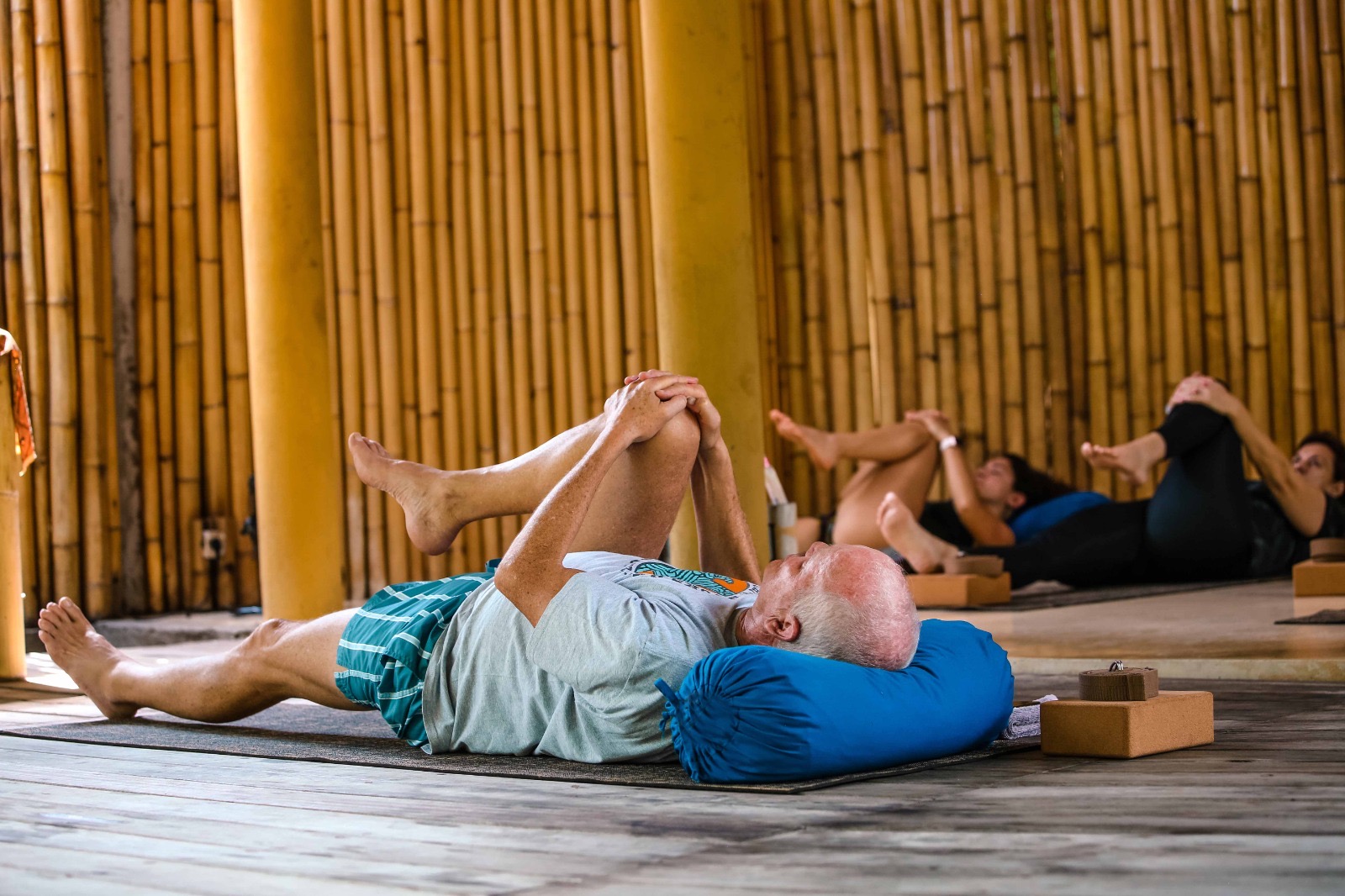Got low back pain? You’re not alone! Worldwide, back pain is the single leading cause of disability, preventing many people from engaging in work as well as other everyday activities.
While low back pain can have chronic and long-term effects, SLOW’s resident physiotherapist Jean-Louis Thonnard is on a mission to find a holistic cure. He’s currently conducting research on Hatha yoga for low back pain, hoping to prove that a regular Hatha yoga practice can significantly relieve—and even cure—chronic low back pain.
We sat down with Jean-Louis to discuss common questions regarding Hatha yoga for low back pain. He explains how the diversity of Hatha yoga postures makes it possible to stretch and strengthen a multitude of muscles and to mobilize the spine in all its degrees of freedom. Our Q+A covers the following regarding yoga for low back pain:
What to engage:
- Strengthen the abdominal muscles and the rotator deep muscles of the trunk.
- Stretch and lengthen the flexor and extensor muscles of the hip.
- Decompress and mobilize the facet joints of the lumbar spine.
How to stretch:
- Stretch slowly and for a long time. This is super important—Jean-Louis explains why in the video!
- Bring your awareness to the lumbo-pelvic-hip dynamics (complementary movements between the lumbar spine and the pelvis).
In the following video, Jean-Louis guides us through beginner-friendly yoga for low back pain, breaking down the science behind how and why these poses work. See our Q+A video recorded below, as well as a transcription of the Q+A with Jean-Louis on yoga for low back pain.
Q: Why is it necessary to strengthen the abdominal muscles and the deep rotator muscles of the trunk?
A: Because the strengthening of its muscles provides significant support to the lumbar spine. The abdominal muscles and the deep rotator muscles are synergistic muscles ie they perform similar actions of flexion, rotation and erection of the trunk. When lifting a load or any other physical effort it is important that the lumbar spine and the core muscles form a real composite beam. Otherwise it is the intervertebral disc and the small joints between the lumbar vertebrae which will have to absorb the mechanical stresses linked to these efforts with a risk of wear and even mechanical damage which generate lumbar pain.
Q: Why stretch and soften the flexor and extensor muscles of the hip?
A: These are multi-articular muscles that bridge the knee and hip joints. If these muscles are too short and lack of extensibility they block the movements of the pelvis and hips and it is again the lumbar spine which must counter this deficit in flexibility by abnormally stressing the lumbosacral hinge. Therefore a good mobility of the hips and pelvis protects the lumbar spine
Q: Why deco-adapt and mobilize the facet joints of the lumbar spine?
A: Because a careful mobilization of these small intervertebral joints can also relieve low back pain. By mobilizing the pelvis in the frontal plane while the shoulders remain immobile in the horizontal plane, torsional movements of the lumbar spine are generated which mobilize and open the joint space of these small facet joints.

Q: Why stretch slowly and for a long time?
A: Stretch slowly because muscles and tendons have viscoelastic properties. The more they are lengthened the more their intrinsic tension increases and the more this elongation takes place quickly the more this intrinsic tension increases over time with the consequences of micro lesions which can also generate pain. The more you stretch slowly the less the intrinsic tension is high and the risk of injury is reduced.
Stretch for a long time to give time to the musculotendinous structures to deform. If the tension generated by the stretch is kept constant for a while then the muscle will continue to lengthen, this is called creep.
Q: Why bring awareness to the lumbo-pelvic-hip dynamics?
A: The movements of the pelvis and the lumbar spine are linked; a tilt of the pelvis forward is accompanied by lumbar lordosis; a tilt of the pelvis towards the back is accompanied by a lumbar de-lordosis. The ideal posture is to keep a physiological lordosis and through certain yoga postures it is quite easy to perceive this complementarity in the movement, the lumbo-pelvic-hip dynamics.
Not sure where to begin? Watch out for Jean-Louis’s beginner-friendly Hatha sequence, bringing you yoga for low back pain. Relieve any tension in the spine from the comfort of your home!
PS. Did you know turmeric is an amazing natural remedy for inflammation, including low back pain? Check out this article for more info!
Looking for more hands-on help? Send us a photo @slowgiliair #SLOWatHOME, and Jean-Louis will respond with personalized posture-correcting tips, including the most beneficial Hatha yoga for low back pain you can practice!
